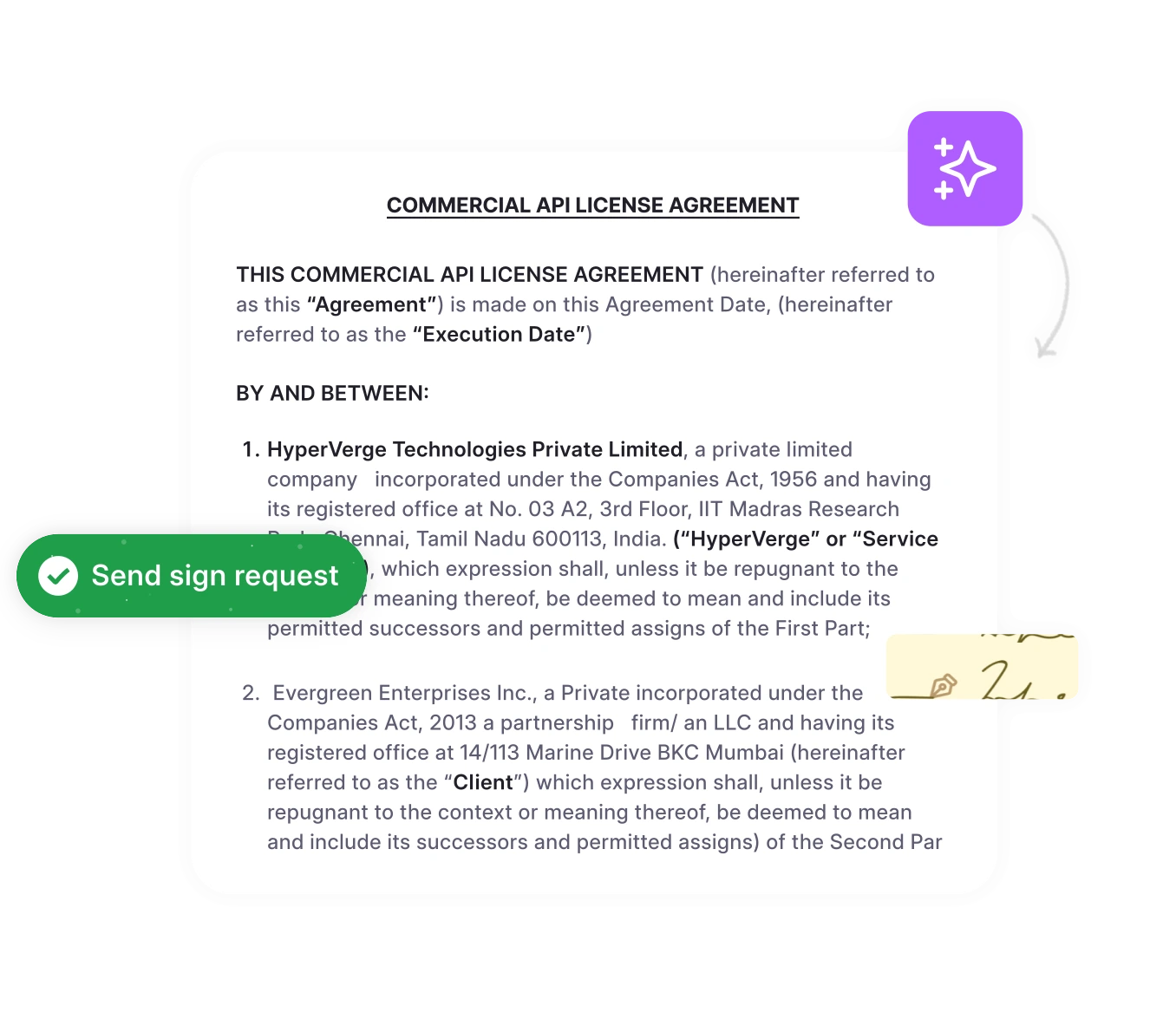Well-drafted and managed contract clauses turn good-faith handshakes into protected partnerships.
This blog covers everything you need to know about them.
Let’s dive in.
What are contract clauses, and why do they matter
Contract clauses are sections within legal agreements that address specific aspects of the business relationship. Each clause covers particular rights, conditions, procedures, and contractual obligations.
The relationship between clauses, terms, and conditions forms the structural foundation of any agreement. While terms define the essential elements of the deal, clauses organize these terms into logical, manageable sections. Conditions specify the circumstances under which obligations become binding or are discharged.
The business impact of well-managed clauses
Manual clause review takes 92 minutes versus 26 seconds with AI—a reduction that translates directly to recovered billable hours and accelerated deal cycles. By automating the assembly of contracts from a library of pre-approved clauses, businesses can drastically reduce the time spent on drafting new agreements from scratch.
This efficiency gain extends beyond time savings. Organizations using contract management software report an 80% faster average cycle time from bid to sign agreement. The standardization of clauses through CLM systems creates consistency across the organization, reducing risk and improving negotiation outcomes.
Go from contract chaos to control
Reclaim time, simplify compliance, and put real-time contract intelligence to work for you at scale.
Book a DemoThe 1 essential contract clauses every business needs
1. Confidentiality
The confidentiality clause guards sensitive information. Purpose and standard language typically define what constitutes confidential information, specify permitted uses, and outline exceptions such as publicly available information or court-ordered disclosures.
2. Indemnification
Indemnification clauses allocate risk between parties by requiring one party to compensate the other for specified losses. These risk allocation mechanisms can be structured as mutual, where both parties provide indemnification, or unilateral, where only one party bears the risk.
3. Limitation of Liability
This clause caps the financial exposure of parties in case of breach or damages. Cap types include monetary limits (fixed dollar amounts) or multiples of fees paid under the contract. The structure you choose depends on the contract value and risk profile. As highlighted in a recent analysis on liability risks, directors and officers can be held liable for failing to implement appropriate compliance safeguards, making these clauses essential for corporate protection.
4. Force Majeure
Post-pandemic expansions have broadened force majeure definitions to include unforeseen circumstances like pandemics, government shutdowns, and supply chain disruptions, to other landmark events like plagues and the Great Depression. Modern clauses specify detailed notice requirements—typically within 5-10 business days of the triggering event.
Operational clauses
5. Payment Terms
Payment terms establish the financial framework of the contract. Net terms (typically Net 30, 60, or 90) define when payment is due after invoice receipt. Early payment discounts (such as 2/10 Net 30) incentivize prompt payment while late payment penalties discourage delays.
6. Termination
Termination provisions define exit strategies for both parties. For-cause termination allows exit upon material breach, typically with notice and cure periods of 30 days. Convenience termination permits exit without cause, usually requiring longer notice periods (60-90 days) and sometimes contract termination fees.
7. Renewal/Auto-Renewal
Renewal structures significantly impact contract management workload. Opt-in structures require affirmative action to continue the contract, while opt-out (evergreen contracts) automatically renew unless terminated within specified notice windows.
8. Change Control
Change control procedures establish how contract modifications are requested, evaluated, and approved. Scope modification procedures should specify who can request changes, required documentation, and impact assessment processes.
Dispute management clauses
9. Dispute Resolution
Modern dispute resolution favors graduated escalation procedures. Initial steps typically involve good-faith negotiations between project managers, escalating to executives if unresolved within specified timeframes.
10. Governing Law
Choice of law considerations extend beyond selecting a favorable jurisdiction under the Federal government laws or state regulations for enforcement. Consider the sophistication of the jurisdiction’s commercial contract law, precedent availability, and alignment with international treaties.
11. Jurisdiction/Venue
The distinction between exclusive and non-exclusive jurisdiction significantly impacts dispute strategy in contracts entered into. Exclusive jurisdiction limits disputes to specified courts, while non-exclusive jurisdiction permits parallel proceedings in multiple forums.
Intellectual property clauses
12. IP Ownership
Intellectual property clauses must clearly distinguish between background IP (pre-existing materials) and foreground IP (newly created materials). Work-for-hire provisions should explicitly state that created works belong to the commissioning party.
13. Warranty and Disclaimer
Warranties can be expressed (explicitly stated) or implied (imposed by law). Express warranties should be specific and measurable, while implied warranties often require explicit disclaimer language to exclude.
Compliance and regulatory clauses
14. Data Protection/Privacy Clause
GDPR and CCPA compliance requirements have standardized many data protection provisions. Cross-border transfer provisions must address data localization requirements and appropriate safeguards for international transfers.
15. Audit Rights
Audit provisions balance transparency needs with operational disruption concerns. Scope and frequency limitations clauses (typically annual, with additional audits for cause) prevent abuse while ensuring adequate oversight.
Industry-specific contract clauses
Technology and SaaS
Service level agreements (SLAs) define performance standards with specific uptime commitments (typically 99.9% or higher). Data portability and deletion provisions address end-of-service scenarios, ensuring customers can retrieve their data in usable formats.
Healthcare and life sciences
HIPAA compliance provisions address protected health information handling, requiring specific safeguards and breach procedures. Clinical trial protocols incorporate FDA requirements and Good Clinical Practice standards.
Financial services
Regulatory capital requirements reflect Basel III and local regulatory frameworks. Anti-money laundering (AML) provisions incorporate know-your-customer requirements and suspicious activity reporting obligations.
Construction and real estate
Liquidated damages provisions pre-establish compensation for delays, avoiding difficult damage calculations. Mechanic’s lien waivers protect property owners from subcontractor claims.
Also read Manufacturing Contracts Guide: Types, Clauses, Best Practices.
Managing contract clauses with CLM: Best practices
Drafting best practices: AI-powered playbooks
The contrast between manual and automated approaches is stark. Manual processes rely on plain language principles, avoiding ambiguity through careful word choice and consistently defined terms. Including specific examples helps clarify intent but requires significant time investment.
Automated approaches leverage pre-approved language templates and no-code workflows. Version control and audit trails are built in, providing transparency and accountability. Automated fallback positions present pre-approved alternatives during negotiations, accelerating agreement while maintaining standards through proper contract drafting.
Negotiation and redlining
Manual negotiation requires identifying must-have versus nice-to-have positions, strategically trading concessions, and maintaining detailed documentation of changes. This process typically consumes hours per contract.
Automated systems transform this landscape. AI-powered playbooks provide consistent guidance across the organization. Microsoft Word integration enables in-line editing with AI-suggested fallback language. Deviation detection from standards alerts legal teams to non-standard terms requiring review.
Clause extraction and analysis
Manual extraction and tracking of contract obligations is error-prone and resource-intensive. Legal teams spend countless hours reading through contracts to identify key terms and obligations.
Automated solutions leverage natural language processing capabilities to identify and extract clause types, obligations, and key terms.
The transformation extends beyond efficiency. These improvements come from systematic clause management through a robust contract clause library that ensures consistency and completeness across the contract portfolio.
Wrapping up
Legal teams can build a systematic approach to clause management. Smart organizations are already moving beyond ad-hoc contract creation toward standardized contracts backed by comprehensive clause libraries. They understand that knowing the elements of a contract isn’t enough anymore—you need technology that can extract, analyze, and apply that knowledge at scale.
Whether you’re handling simple contracts for routine purchases or complex contractual relationships worth millions, the fundamentals remain: clear terms, manageable risks, and enforceable agreements. Teams that master how to write a contract using contract law principles while leveraging automation will outpace those stuck in manual workflows.
19845Without a CLM, you’re prone to missed renewals, untracked obligations, and legal exposure hiding in thousands of unmanaged documents. Modern CLM platforms turn chaos into control, whether you’re drafting a quick contract summary or negotiating complex limitation of liability provisions.
The question isn’t if you’ll modernize—it’s whether you’ll lead the change or scramble to catch up.










